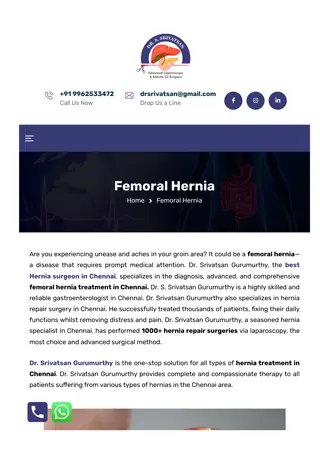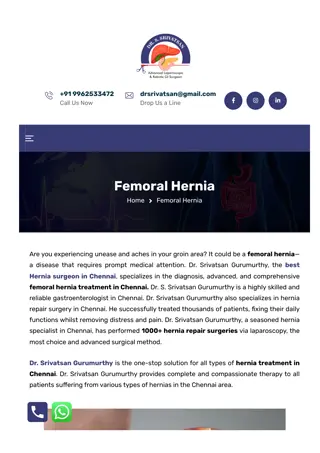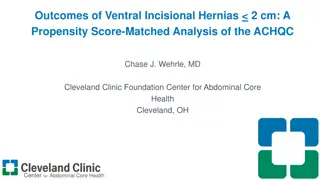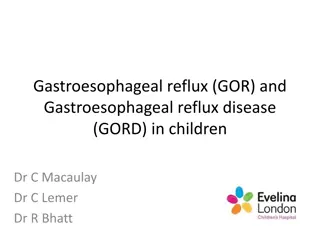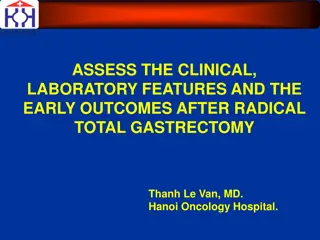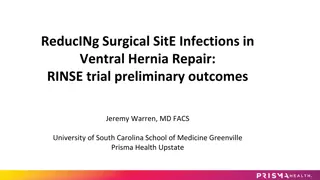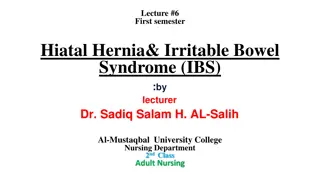Reflux After Sleeve Gastrectomy and Hiatus Hernia Repair: Suture vs. Mesh Study
This study compares suture and mesh repairs for concomitant hiatus hernia in patients undergoing laparoscopic sleeve gastrectomy (LSG) to evaluate reflux outcomes. Results show mesh repair provides significant benefit in managing post-operative reflux. Ongoing research is investigating reflux symptoms in patients post-sleeve gastrectomy.
Download Presentation

Please find below an Image/Link to download the presentation.
The content on the website is provided AS IS for your information and personal use only. It may not be sold, licensed, or shared on other websites without obtaining consent from the author.If you encounter any issues during the download, it is possible that the publisher has removed the file from their server.
You are allowed to download the files provided on this website for personal or commercial use, subject to the condition that they are used lawfully. All files are the property of their respective owners.
The content on the website is provided AS IS for your information and personal use only. It may not be sold, licensed, or shared on other websites without obtaining consent from the author.
E N D
Presentation Transcript
Chapter 9: Markov Processes Market Share Analysis Transition Probabilities Steady-State Probabilities Absorbing States Transition Matrix with Submatrices Fundamental Matrix Slide 1
Markov Processes Markov process models are useful in studying the evolution of systems over repeated trials or sequential time periods or stages. the promotion of managers to various positions within an organization the migration of people into and out of various regions of the country the progression of students through the years of college, including eventually dropping out or graduating Slide 2
Markov Processes Markov processes have been used to describe the probability that: a machine that is functioning in one period will function or break down in the next period. a consumer purchasing brand A in one period will purchase brand B in the next period. Slide 3
Example: Market Share Analysis share and customer loyalty for Murphy s Foodliner and Ashley s Supermarket, the only two grocery stores in a small town. We focus on the sequence of shopping trips of one customer and assume that the customer makes one shopping trip each week to either Murphy s Foodliner or Ashley s Supermarket, but not both. Suppose we are interested in analyzing the market Slide 4
Example: Market Share Analysis the trials of the process. Thus, at each trial, the customer will shop at either Murphy s Foodliner or Ashley s Supermarket. The particular store selected in a given week is referred to as the state of the system in that period. Because the customer has two shopping alternatives at each trial, we say the system has two states. We refer to the weekly periods or shopping trips as State 1. The customer shops at Murphy s Foodliner. State 2. The customer shops at Ashley s Supermarket. Slide 5
Example: Market Share Analysis we collect data from 100 shoppers over a 10-week period. In reviewing the data, suppose that we find that of all customers who shopped at Murphy s in a given week, 90% shopped at Murphy s the following week while 10% switched to Ashley s. Suppose that, as part of a market research study, Suppose that similar data for the customers who shopped at Ashley s in a given week show that 80% shopped at Ashley s the following week while 20% switched to Murphy s. Slide 6
Transition Probabilities Transition probabilities govern the manner in which the state of the system changes from one stage to the next. These are often represented in a transition matrix. Slide 7
Transition Probabilities A system has a finite Markov chain with stationary transition probabilities if: there are a finite number of states, the transition probabilities remain constant from stage to stage, and the probability of the process being in a particular state at stage n+1 is completely determined by the state of the process at stage n (and not the state at stage n-1). This is referred to as the memory-less property. Slide 8
Example: Market Share Analysis Transition Probabilities pij= probability of making a transition from state i in a given period to state j in the next period p11p12 0.9 0.1 P = = p21p22 0.2 0.8 Slide 9
Example: Market Share Analysis State Probabilities Murphy s .9 P = .9(.9) = .81 Murphy s .9 Ashley s P = .9(.1) = .09 Murphy s .1 Murphy s P = .1(.2) = .02 .2 Ashley s .1 P = .1(.8) = .08 Ashley s .8 Slide 10
Example: Market Share Analysis State Probabilities for Future Periods Beginning Initially with a Murphy s Customer State Probabilities for Future Periods Beginning Initially with an Ashley s Customer Slide 11
Steady-State Probabilities The state probabilities at any stage of the process can be recursively calculated by multiplying the initial state probabilities by the state of the process at stage n. The probability of the system being in a particular state after a large number of stages is called a steady- state probability. Slide 12
Steady-State Probabilities Steady state probabilities can be found by solving the system of equations P = together with the condition for probabilities that i= 1. Matrix P is the transition probability matrix Vector is the vector of steady state probabilities. Slide 13
Example: Market Share Analysis Steady-State Probabilities Let 1= long run proportion of Murphy s visits 2= long run proportion of Ashley s visits Then, .9 .1 [ 1 2] = [ 1 2] .2 .8 continued . . . Slide 14
Example: Market Share Analysis Steady-State Probabilities .9 1 + 2 = 1 (1) 1 + 2 = 2 (2) 1 + 2 = 1 (3) Substitute 2 = 1 - 1 into (1) to give: 1 =.9 1 + .2(1 - 1) = 2/3 = .667 Substituting back into (3) gives: 2 = 1/3 = .333 Slide 15
Example: Market Share Analysis Steady-State Probabilities Thus, if we have 1000 customers in the system, the Markov process model tells us that in the long run, with steady-state probabilities 1= .667 and 2= .333, 667 customers will be Murphy s and 333 customers will be Ashley s. Slide 16
Example: Market Share Analysis an advertising campaign to attract more of Murphy s customers to its store. Let us suppose further that Ashley s believes this promotional strategy will increase the probability of a Murphy s customer switching to Ashley s from 0.10 to 0.15. Suppose Ashley s Supermarket is contemplating Slide 17
Example: Market Share Analysis Revised Transition Probabilities Slide 18
Example: Market Share Analysis Revised Steady-State Probabilities .85 1 + .20 2 = 1 (1) .15 1 + .80 2 = 2 (2) 1 + 2 = 1 (3) Substitute 2 = 1 - 1 into (1) to give: 1 = .85 1 + .20(1 - 1) = .57 Substituting back into (3) gives: 2 = .43 Slide 19
Example: Market Share Analysis Suppose that the total market consists of 6000 customers per week. The new promotional strategy will increase the number of customers doing their weekly shopping at Ashley s from 2000 to 2580. If the average weekly profit per customer is $10, the proposed promotional strategy can be expected to increase Ashley s profits by $5800 per week. If the cost of the promotional campaign is less than $5800 per week, Ashley should consider implementing the strategy. Slide 20
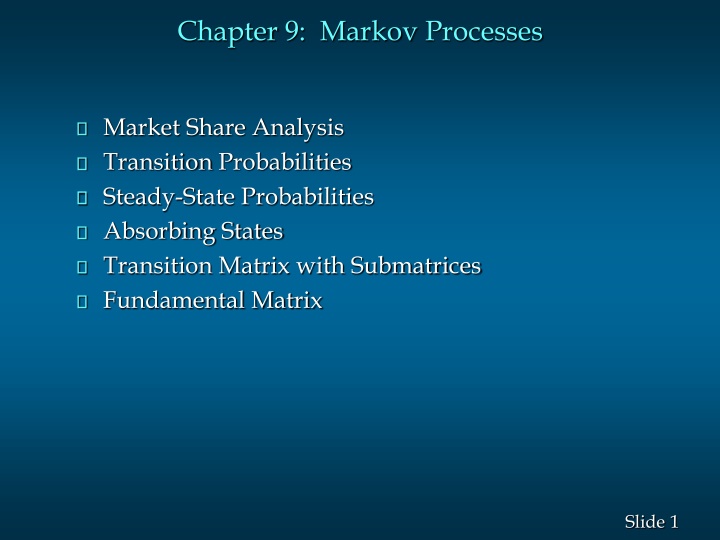


![Guardians of Collection Enhancing Your Trading Card Experience with the Explorer Sleeve Bundle [4-pack]](/thumb/3698/guardians-of-collection-enhancing-your-trading-card-experience-with-the-explorer-sleeve-bundle-4-pack.jpg)



